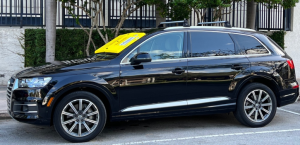By Jeff Sanford
Toronto, Ontario — February 26, 2018 — In this week’s AV Report, the Center for Automotive Research
(CAR) lets some air out of the AV hype, a scientist suggests a drivers’ test for AVs, GM’s SuperCruise is tested, and much, much more.
– Major automakers, Wall Street fund managers and Silicon Valley start-up gurus are racing to invest billions into the new technologies for AVs. Sensors, artificial intelligence (AI) software, properties for fleet management properties; it is all up in the air right now. Winners are going to make substantial amounts of money from this newly emerging industrial sector.
No one was talking seriously about AVs four years ago but there is, quite suddenly, an entirely new industry happening. The world’s largest businesses are being reinvented. The digital tech of Silicon Valley is merging with the heavy steel of Detroit auto manufacturers for the first time in history. The potential is immense. No wonder there is so much investment cash rolling into the many small companies popping up to offer the optical sensors, artificial intelligence and electric motors that the AV sector will need.
But might the early eagerness be tending toward overconfidence? This is something analysts at CAR wonder. In a recent report the firm questions whether AV adoption will happen as quickly as many now predict. There is a sense among some that AVs are imminent. But according to CAR the emergence of large fleets of true AVs is years away yet. AVs will represent only a fraction of sales even a decade from now. According to a Detroit newspaper, “In a Wednesday presentation to automotive media, the Ann Arbor, Mich.-based research group said Level 4 and Level 5 self-driving vehicles will account for less than 4 percent of new-vehicle sales by 2030, although that number will increase steadily to roughly 55 percent by 2040…
Separately, CAR said it believes alternative powertrains, including battery-electric and fuel cell vehicles, will comprise 8 percent of the market by 2030… Government emissions and fuel economy mandates are helping drive this push into future technologies, and CAR said self-driving tech and electrification will first impact fleets of shared vehicle services in dense urban areas. But an economic downturn, a slowing new-vehicle sales market or lack of public acceptance could significantly hinder their broader implementation in personal cars and trucks. That is, an AV economy is still years away.
-It was reported that Austrian biometric company AMS is about to build a new factory to produce optical sensors for cars. The company is the supplier of the optical sensing devices being used in Apple’s face-based biometric technology. Now that the iPhoneX is on the market, earnings are washing back through AMS, which is flooded with cash these days. The company is hustling hard to meet the new and growing demand for the parts that allow face-based ID, and that’s doing amazing things for the stock price. Shares in the company trade in Zurich, Switzerland. The stock tripled in value last year. It was was the single best performing in the Stoxx 600 index of European equities. The company has an unidentified customer providing $150 million to set up a new plant as everyone rushes to build the capacity to do the face ID now that the iPhoneX is using. The company providing AMS the cash for the new factory is a company that uses the product. It’s not a bank putting up the money. It will hire 8,000 employees for this new project. It’s happening in Singapore. The new facility will help meet the growth in demand for 3D image and optical sensing equipment that is now occurring. http://bit.ly/2GGAnOG
-An essay reprinted in highly-regarded magazine Scientific American wonders if self-driving cars should have to pass a driver’s test. The learning-based software being used in these cars can be hard to evaluate, according to the author of the column. A researcher in AVs suggests that researchers, “… can’t always tell exactly why something works, but they can evaluate the outcome…” for that reason, AVs should have to prove they can negotiate a basic track before they are allowed on streets. The emergence of self-driving cars has so far occurred with minimal government oversight. According to the author, “There’s no testing track like the country’s actual roads, and no way to test these new machines as thoroughly as modern human-driven cars have been, with trillions of miles driven every year for decades. When self-driving cars do hit the road, they crash in ways both serious and minor. Yet all their decisions are made electronically, so how can people be confident they’re driving safely? … Driving cars are expected to improve road safety, freeing up drivers’ time and attention and transforming cities and even societies… The regulations that are created for self-driving cars will have massive effects that ripple throughout the economy and society. … federal regulations could – and should – require testing for self-driving cars’ algorithms. To date, governments have tested cars as machines, ensuring steering, brakes and other functions work properly. Of course, there are also government tests for human drivers,” says the author. The author goes on to say that tests should examine, “… what the algorithms direct the car to do on freeways with trucks and in neighborhoods with animals, kids, pedestrians and cyclists. Testing should also look at what the algorithms do when both vehicle performances and sensors’ input is compromised by rain, snow or other weather conditions. Cars should run through scenarios with temporary construction zones, four-way intersections, wrong-way vehicles and police officers giving directions that contradict traffic lights and other situations.” Sounds reasonable. http://bit.ly/2GDVAIL
-General Motors’ (GM) SuperCruise is finally coming out. To generate a map that the system will rely on, GM sent out a fleet of Lidar-equipped vehicles to map the U.S. Interstate system, as well as parts of Canada and China. A report in the auto press notes that “Cadillac’s communications strategy around it is clearly designed to mitigate the likelihood of an accident like Josh Brown’s, which was the result of Brown engaging Tesla Autopilot on a two-way highway, then failing to intercede before his Model S struck a tractor-trailer that was making a left turn across his path of travel, and which Autopilot failed to recognize.”
Brown is now famous in death for being the first person killed in an AV accident. The auto reporter that tested the system did so in both New York and Los Angeles. It sounds like there are some bugs to work out yet. According to the reporter, “In and around Los Angeles, SuperCruise was excellent, working exactly where I expected it to, and disengaging as I approached exits and interchanges – most of the time. I quickly learned that if you’re on the I-10 eastbound and want to exit left onto the northbound 110, SuperCruise inexplicably remains active seconds after I expected it to have disengaged; e.g. clearly after the transition from highway driving to beginning to exit the highway.” According to the piece SuperCruise will not exit a highway of its own accord. The reporter notes that, “Seconds of uncertainty seem like an unsafe eternity when using these systems. … In and around NYC, it was almost impossible to engage SuperCruise, even under excellent conditions. It worked eastbound on the Long Island Expressway but not westbound, and it barely worked on the Grand Central Parkway. Then, inexplicably, the little gray steering wheel icon on the dash lit up on the FDR Drive northbound, indicating SuperCruise was available. I activated the system; it worked for about six seconds before disengaging. This happened twice more. GM has some work to do.” http://bit.ly/2EOnrtC
-Autonomous cars require powerful sensors to see and advanced software to think. They will also make use of up-to-the-minute maps. And so dozens of contenders are competing to capture the market for digital maps that AVs can utilize. According to a magazine article this past week these companies are, “… burning tens of millions of investment dollars in pursuit of a massive payoff that could be years away. Alphabet Inc.’s Google emerged years ago as the winner in consumer digital maps, which human drivers use to evade rush-hour traffic or find a restaurant. Google won by blanketing the globe with its street-mapping cars and with software expertise that couldn’t be matched by navigation companies, automakers and even Apple Inc. Nobody wants to let Google win again.” The german automakers acquired a map making company. Some contenders are creating, “… complete high-definition maps that will let the driverless cars of the future navigate all on their own.” Other companies are taking the other route by creating, “… maps piece-by-piece, using sensors in today’s vehicles that will allow cars to gradually automate more and more parts of driving.” GM, Uber and Ford all have fleets out on the roads to “… create rich, detailed HD maps for use in driverless cars… Unlike conventional digital maps, self-driving maps require almost-constant updates. The slightest variation on the road – a construction zone that pops up overnight, or a bit of debris – could stop a driverless car in its tracks…. Intel Corp hits front-facing camera and chip sensor that it plans to place in two million cars this year. The idea is to get cars to view such things as lane markers, traffic signals and road boundaries, letting them automate some driving… Civil Maps has tech that ‘fingerprints’ sensor data, forming digital grids with each loop made by a mapping vehicle around the same area. It’s a bit like the way the mobile app Shazam recognizes a piece of music, said [the CEO]. Ford is an investor. The company is in the process of raising additional money. https://bloom.bg/2EHQlY4





































